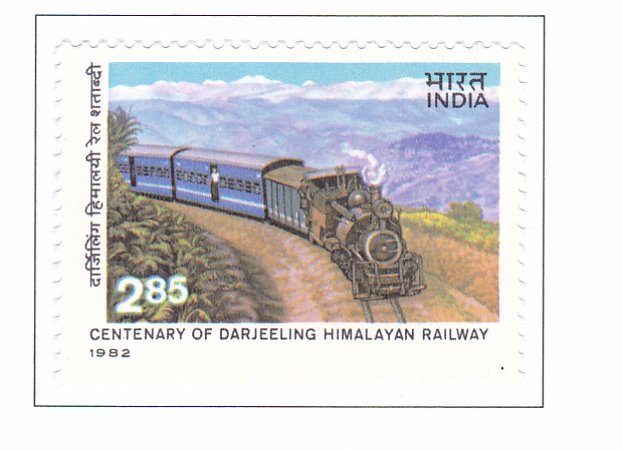Centenary of Darjeeling Himalayan Railway

Technical Data
| Date of Issue | December 18, 1982 |
|---|---|
| Denomination | Rs. 2.85 |
| Quantity | 2,000,000 |
| Perforation | comb 13¼ x 13 |
| Printer | Security Printing Press, Nashik |
| Watermark | No Watermark |
| Colors | Multicolor |
| Catalog Codes |
Michel IN 934 Stamp Number IN 1004 Yvert et Tellier IN 745 Stanley Gibbons IN 1069 |
| Themes | Anniversaries and Jubilees | Locomotives | Railways | UNESCO World Heritage Sites |
Celebrating the Darjeeling-Himalayan Railway: A Marvel of Engineering and Beauty
The Darjeeling Himalayan Railway, winding through the majestic peaks of the Himalayas, stands as a testament to both human ingenuity and natural beauty. Conceived by Franklin Prestage, the agent of the Eastern Bengal Railway, this unique narrow-gauge railway line stretches from Darjeeling to Siliguri, spanning a distance of 87.48 kilometers.
Engineering Feats and Unique Features
This railway line, with its two-feet-wide track, traverses through different climate zones, offering breathtaking views and picturesque scenery. The alignment of the railway, often running parallel to the famous Hill Cart Road, creates a mesmerizing spectacle as they intertwine at various points along the route.
Innovative Construction Techniques
The engineers of the Indian Railways employed innovative techniques to overcome the challenges of steep gradients and rugged terrain. Inspired by Chega, an Austrian engineer who pioneered the construction of hill railways by utilizing looping to flatten gradients, the Darjeeling-Himalayan Railway was constructed without the need for expensive tunnels. The use of loops and reverses allowed the railway to ascend the hills efficiently, with 4 loops, 5 reverses in the shape of ‘Z,’ and numerous bridges and level crossings along the section.
Historical Significance and Expansion
Construction of the railway began in 1878 and was completed in July 1881, marking a significant milestone in railway engineering. In October 1948, the Government of India acquired the railway line as part of the New Assam Link Project. Subsequently, the narrow-gauge line was extended from Siliguri to New Jalpaiguri in 1962, further enhancing connectivity in the region.
Enduring Legacy and Commemoration
The Darjeeling-Himalayan Railway boasts a rich heritage, with its oldest steam locomotive, a ‘B’ class engine, set to celebrate its centenary in 1985. Additionally, the youngest engine in the fleet has already completed 50 years of service. To honor the railway’s legacy and contribution to the region’s development, the Indian Posts & Telegraphs Department is delighted to issue a commemorative stamp on the Darjeeling-Himalayan Railway.
Conclusion
As the Darjeeling-Himalayan Railway continues to charm travelers with its scenic beauty and historic significance, it remains a symbol of human achievement and perseverance in the face of daunting challenges posed by nature.
[Text by courtesy: Ministry of Railways (Railway Board)]
